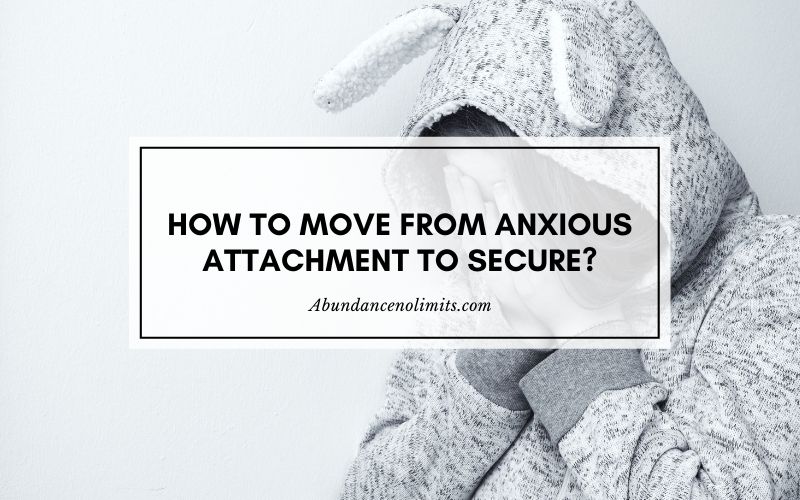Your attachment style plays a major role in the health and longevity of your relationship. The way you connect with your partner, your behavior, and your response to the behavior of your partner can influence the way your relationship turns out.
Having a secure attachment style gives you an undeniable advantage in the tricky world of relationships. However, not all are fortunate to have a secure attachment style.
If you have any one of the insecure attachment styles – avoidant, anxious, and anxious-avoidant – there is no need to lose hope. You can still work on your attachment style and transform it into a secure one.
This article details ways to deal with anxious attachment style and how to become securely attached.
Attachment theory and styles
Based on how a caregiver responds to a child, the child develops an attachment style. As humans are born without means to sustain themselves, they are hardwired to search for attachments for survival.
Attachment style develops in an infant early on – in the first year itself. And, this will remain with the child for the rest of its life, if nothing is done to deliberately change it.
A quick tour of attachment styles and how they are formed:
Secure attachment:
Caregivers are receptive and aligned to the needs of the child. The child feels secure with the caregiver and distressed when they are away.
Anxious attachment:
Caregivers are unpredictable and inconsistent in their dealings with the child. At times they are excessively involved but at other times they are withdrawn. These fluctuations in the behavior of the caregiver make the child anxious and confused. The child longs for attention and affection.
Clinginess, jealousy, distrust, low self-esteem, and inability to deal with intimacy despite longing for it are the common signs.
Avoidant attachment:
Caregivers are not available, receptive, or responsive. They are often distant and dismissive. The emotional disconnection of the caregiver from the child leads to the child suppressing its outward display of emotions. They fear rejection from the caregiver if they show emotions.
Avoidant attachment triggers are the display of emotions, intimacy, unpredictable situations, criticism, dependency, and demand for attention.
Anxious-avoidant attachment:
Also known as fearful-avoidant, this combines the ill-effects of both anxious and avoidant styles. The child is anxious for attention and affection but avoids it at all costs. Though rarer than the other attachment styles, the anxious-avoidant style involves difficulty in controlling their emotions, inappropriate response to negative emotions, display of violence, and constant change of sexual partners.
Why should you try to move towards a secure attachment style?
After understanding more about the different attachment styles and their symptoms and triggers, you would have a fair idea of what kind of attachment style you have. If you are securely attached, it is a good situation. But you can continue to improve it.
In case, you come under any one of the insecure attachment styles, you need to work on it and move towards a more secure attachment. Here are some of the reasons why you should strive for a more secure attachment.
- Better self-worth and self-image
- Strong, healthy, intimate, and well-adjusted relationships
- Trust and secure feeling about self and others
- A feeling of independence in relationships
- A positive attitude about self and life in general
- Robust coping and problem-solving skills
- Firm determination and strong willpower
You would be able to change your attachment style from insecure to secure with the help of strong desire, patience, perseverance, and self-awareness. By becoming securely attached, you will be able to build relationships that are more honest, open, and fulfilling.
How to fix anxious attachment style?
Attachment styles, once formed as an infant, usually remain the same throughout the lifetime of an adult. However, with dedicated effort, it is possible to move from insecure attachment styles to more secure ones.
As this is a major change in the mindset of an adult, it is not an easy or overnight process. If you are attempting this move, you will need oodles of willpower and patience, and willingness to persist despite setbacks.
The first step in the transformation is to become more aware of your current attachment style; here it is the anxious attachment. You can get help from a therapist to understand why and how you developed the style and what are its ramifications.
More importantly, how your anxious style is creating roadblocks in your relationship and how it is affecting your behavior and response.
The next step is to devise a strategy for healing anxious attachment to feel more secure.
One of the main handicaps of a person with anxious attachment is communication or the lack of it. You need to learn to communicate your needs with clarity. This can bring down anxiety levels in you. As your communication skills improve, you will be able to view your partner clearly and not with a perspective tinted by your affliction.
As you slowly start gaining a grip on your emotions, get help from your partner with open communication. The more you share, the better will be your emotional state and the closer you will be to a secure style.
If your partner is understanding and the two of you are ready to work together to sort out your attachment issues, it is possible to self-soothe your anxious attachment. You can also get help from affirmations for anxious attachment.
Here are some samples of affirmations to get you started.
- I am safe and secure.
- I am doing my best.
- I believe that things will turn out fine.
- I am in charge and I feel calm.
- I deserve to be loved and appreciated.
- My feelings are valid.
- I can clearly communicate my needs.
- I deserve to be respected and my opinions valued.
- It is healthy to depend on each other in a relationship.
- It is okay to be independent in a relationship.
Steps to change your attachment style to a more secure one
- Get help from others to manage your emotions. Communication is the main hurdle for those with anxious attachment. Ask for help if need be.
- Pay attention to your “conversations”. If you are attentive enough, you will notice that most of your so-called “talks” are venting sessions on your part. They are more of a monologue in which the other person rarely contributes anything. Consciously change this behavior.
- Take steps to resolve your past hurts. Unresolved issues from the past tend to color your present. Learn to let go of them.
- Watch and learn from more securely attached people. If you are finding it difficult to understand the difference between the two styles by reading up on the topic, you should be able to know more by watching more secure people. This may inspire you to make the move to be more secure.
- In case you feel your current relationship is detrimental to your mental health, decide to let it go. There is no point in clinging on to a relationship when it is hurting you.
You may follow these to remove anxiety and help you calm down.
- Pursue your passions and engage in things that make you happy.
- Get out of your comfort zone. Take care not to overdo it.
- Improve your physical health with workouts and activities.
- Treat yourself with kindness and compassion.
- Take steps to improve your self-awareness, understanding, and insight.
Concluding thoughts
Instead of feeling anxious, ashamed, and uncomfortable about your clinginess and dependency, you can take matters into your hand and work towards improving your mindset and thereby your relationships.
Accepting your attachment style as insecure is clearly the first step in your journey to a more secure style.
Recommended Reading:


